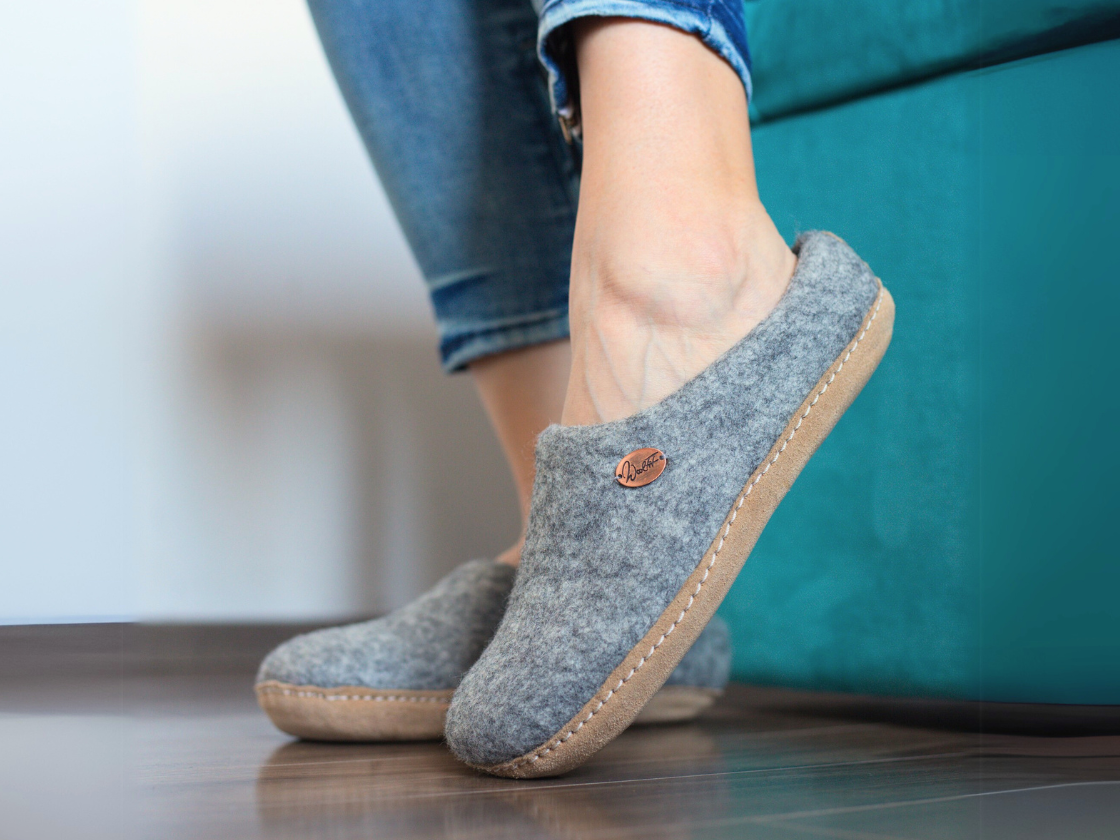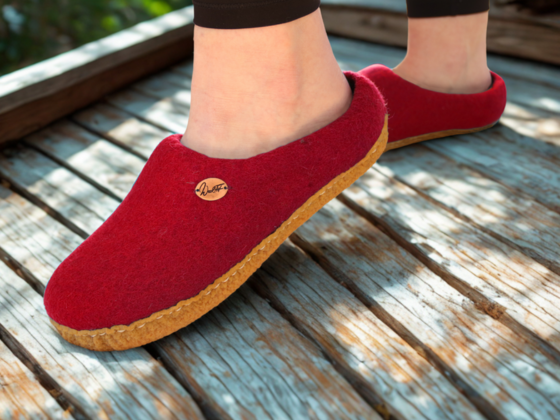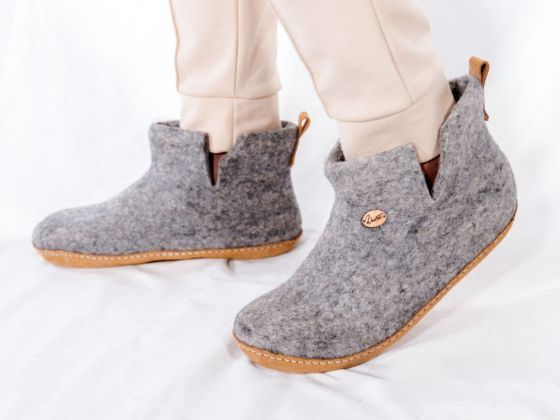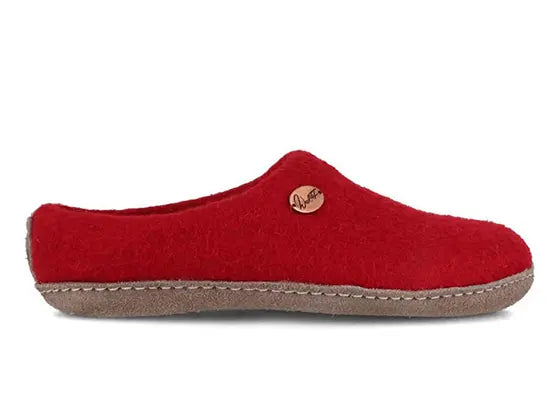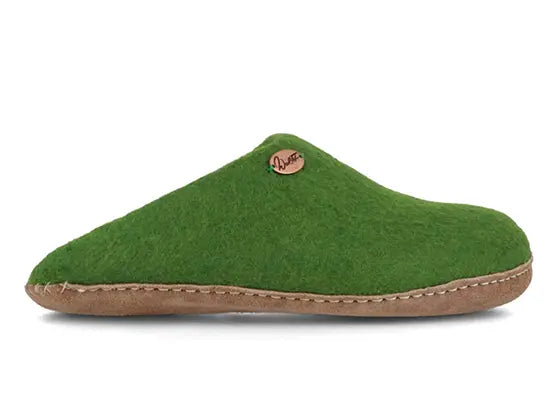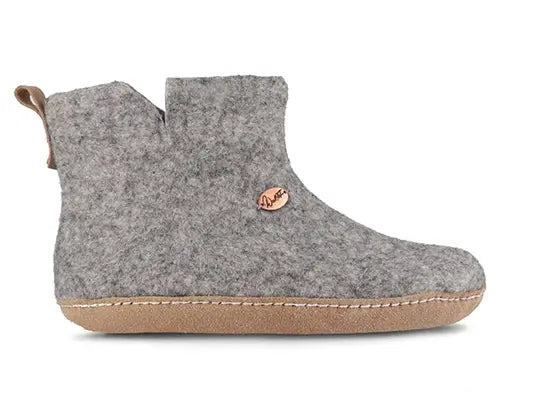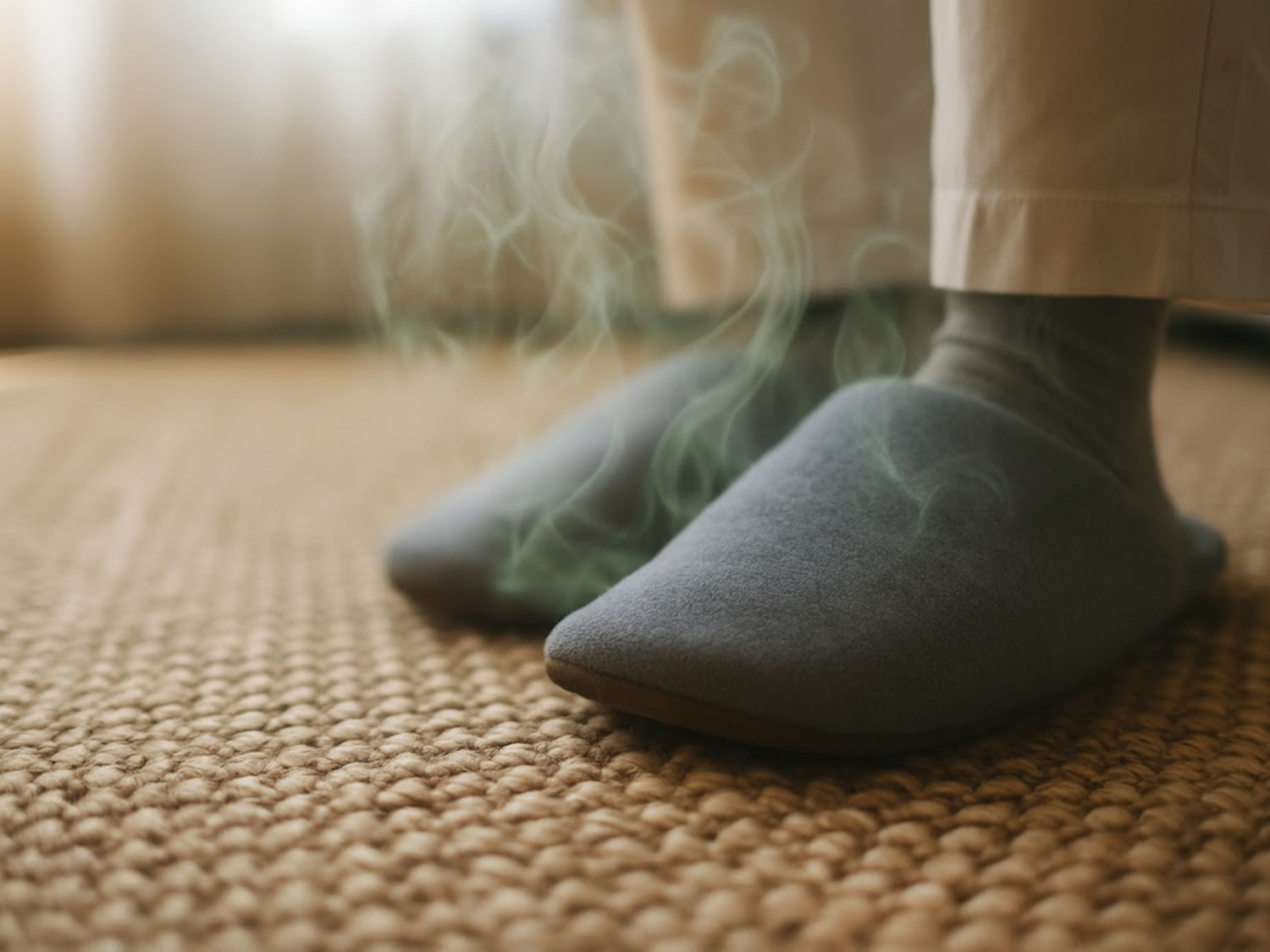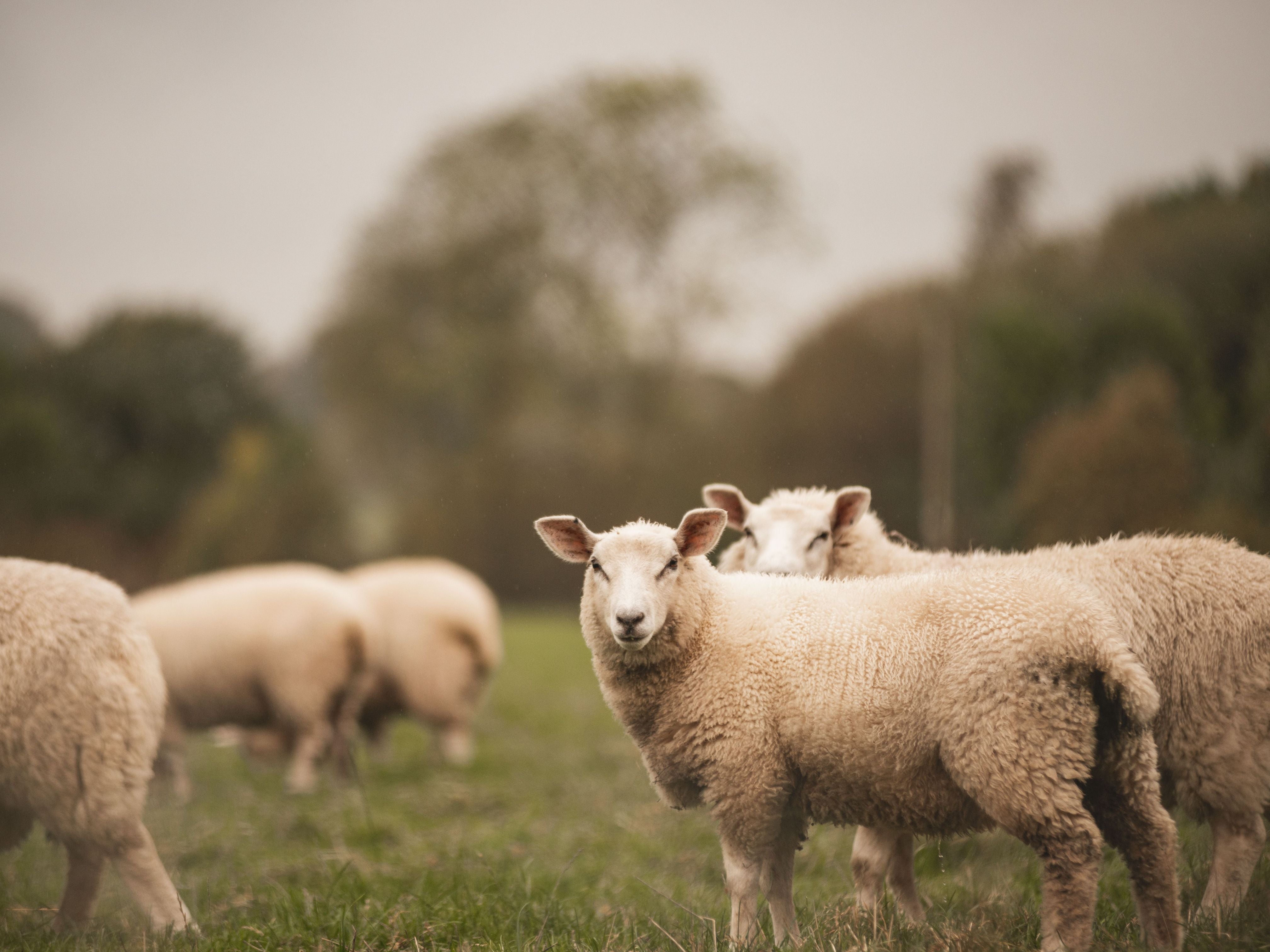For most folks, wearing slippers is synonymous with comfort and relaxation. It's a piece of clothing for your home that enables you to enjoy time on the couch and still feel cozy. But for slipper enthusiasts, it can pose an issue: being able to wear your slippers in public without them smelling funky.
Foot odor — is possibly the most embarrassing body odor out there associated with the human foot and is caused by the bacterial breakdown of sweat and skin oils.
But there's good news! You do have choices in slippers that will keep your feet odor-free.
Know this — if you choose your slippers based on the color and price, well, soon enough you'll be kicking yourself for thinking those synthetic slippers will do the trick with odor.
Face it — no one wants to wear shoes that smell. You might wear them for a couple of hours, which is all you need for the day, but when you take them off after work, you don't want to walk around your house like that.
Many parents know that sending their children to school in a car with leaky fuel or a flammable product can have devastating effects. Similarly, they are also aware that the gases released from synthetic fillings can be toxic, and having this next to your skin is not ideal.
As a result, they have started switching to wool and other natural fibers that are safer, more comfortable, and soft.
Choosing between a wool slipper and a synthetic one can be overwhelming. Manufacturers will try to convince you that their product is the best, but it can be hard to know who to trust:
-
Wool slippers tend to be expensive, but they can provide all-day comfort and deter odor better than synthetic slippers may.
-
Wool does not absorb odors, it actually repels them. That means you don't have to worry about your shoes developing an odor months after buying them.
Note: Wool doesn't wear like synthetics. It requires special cleaning, storage, and care that is quite different from what we're used to treating store-bought synthetic garments with. Still, the benefits of wool far outweigh the costs. And even though they take more active engagement, they don't require any more time than new synthetics do to prevent odor buildup.
— Have you ever wondered what makes wool smell good and how does it compare to synthetic?
We hope to give you a brief overview of how odor resistance works, what factors play a role in it, and the difference between how wool and synthetic slippers deal with clothing odor so you can decide which is best for you.
Let’s go!
Understanding the nature of odor in slippers
It is possible for slippers to smell bad, even when you don't wear them for long periods of time or when your feet are clean.
There are a number of factors that can contribute to this, from poor ventilation to the material the slippers are made from.
Odors from our footwear are actually caused by bacteria and mildew that thrive in humid conditions. This occurs as the feet sweat during wear and the moisture gets trapped inside the slippers. As the dampness is there, bacteria and mildew find it easy to grow and release pungent odors. As they break down the sweat, they actually combine the sweat with secretions from their own cells to form a poisonous gas that smells terrible. The moisture, chemicals, and microorganisms in sweat cause a variety of odors that are unpleasant not just for the wearer but also for anyone who happens to smell them.
Source: ASM
Odor in slippers is a challenging problem to solve because the moisture and conditions that cause odor exist in a confined space. This is why it is common for these enclosed slipper environments to have a much stronger odor than shoes, which could have been worn outside of this warm and moist environment.
A variety of other factors can cause slippers to give off a foul odor:
-
moisture seeps into the slippers and stains remain on the inside of the slipper;
-
odor-causing bacteria can grow on the insides of the slippers if they are not cleaned or dried properly after use;
-
poor quality materials such as plastic or PVC on the inside of the shoes. These materials do not breathe and allow your feet to sweat and give off an odor.
Wool slippers: Odor-resistant features
Hiking, backpacking, camping — whatever you want to call it — people spend a lot of time in the great outdoors, and it can really stink when your feet get sweaty, especially if you've been hiking for hours or days on end.
And let's be honest, the smell is a huge turn-off.
As natural products, wool fibers have unique properties that make them suitable for those who have sensitive feet or struggle with odor. Let’s find them out!
The natural properties of wool that make it resistant to odor:
-
Moisture-wicking
Wool is made up of keratin, the same protein that is the main component in human hair and skin, therefore it has a high fiber content which provides its insulating properties, but also its water and odor resistance properties.
Hydrophobic fibers prevent water from entering their structure because they are non-polar and will repel water molecules. Wool fibers also have scales on their surface, which provide an irregular structure that scatters light and resists absorption, again making the wool fiber hydrophobic.
Note: These scales also protect wool fibers from bacteria and help to inhibit bacterial growth.
Source: MDPI
When we wear wool, it draws moisture to the outer layer. As moisture evaporates from the outer layer of wool, lanolin is left behind. Eventually, this acts as a water repellent on the material.
Fact: Wool fibers have also been shown to reduce foot odor by creating a mild electric charge when they come into contact with sweat. This leaves a thin layer of positively-charged ions between the fiber and your skin. When odor-causing bacteria come in contact with negatively charged skin cells, wool fibers help to kill off these bacteria, reducing the occurrence of foot odor.
-
Breathable
One of the most common reasons for odor on our feet is moisture buildup due to not allowing proper circulation.
— You don't let a cake sit in the oven with no air circulation, right?
The natural composition of wool fibers allow for proper ventilation and prevent unpleasant odor from building up. Heat is quickly dissipated through the layers of wool fiber, preventing excess buildup. This dissipation of heat also prevents the "sweating" that can lead to odor.
Source: ResearchGate
If you have ever walked around in wool slippers on a sunny day then you know that it feels nice and cool on your feet. This happens because wool slippers are naturally breathable which keeps your feet at a reasonable temperature. Wool is also a porous material that allows moisture to pass through which keeps odor sources from collecting in the fabric where they could grow.
-
Antibacterial
What most people don't know is that wool is naturally resistant to odor.
-
Wool contains lanolin, a natural oil that locks in microscopic air bubbles found in the skin, called capillary pouches. Further still, lanolin, a natural oil found in wool, is also antibacterial and antifungal. This makes wool slippers resistant to odor while also inhibiting the growth of odors or additional bacteria down the road.
Other fabrics like cotton can become dirty easily but wool is resistant to dirt, making it ideal for people who are very active or live in places where they sweat a lot, such as athletes and professionals in the medical field.
Note: Wool is naturally chemical resistant while many other fabrics, including synthetics, can react to specific chemicals within detergents or body secretions and break down over time.
Synthetic slippers: Odor-resistant features
-
Antimicrobial treatments
When we smell something that is offensive, what we are sensing is often not the material producing the odor. Instead, it is likely due to the microbial growth on that material.
The challenge for antimicrobial treatments for textiles — is to eliminate odor-causing organisms without interfering with the fabric's functional properties such as colorfastness, breathability, and comfort.
Antimicrobial treatments use chemical agents that inhibit the growth of bacteria, fungi, and other microorganisms that can cause odors. These agents include quaternary ammonium compounds (QACs), imidazole derivatives, bacitracin, parabens, and triclosan. While the body naturally generates its own antimicrobial properties, antimicrobial treatments are also used as a way to prevent or inhibit illness caused by bacteria.
-
Silver ion technology
Synthetic fabrics have had a reputation for poor airflow and a lack of breathability. In terms of wicking properties, wool fabrics often outperform synthetic fabrics. Once synthetic slippers are stained, it can be difficult to get the stench out. As a solution to this issue, researchers around the world have worked on ways to prevent both stains and smells from ever occurring in synthetic materials by using odor molecules like silver ions in their fibers.
Products infused with silver ions and other antimicrobial agents help control the growth of funk-causing microorganisms on fabrics, which prevents odor in their tracks.
— How does it work?
The silver ions are attracted to the odor-causing bacteria where they bind with the metabolism of the bacteria. As a result, bacteria growth is inhibited.
Silver ions embedded in the material substrate are released via ambient moisture and enter the cell membrane.
Silver ions destabilize cell membranes, stop respiration and inhibit cell division, whilst blocking the replication of DNA.
Source: Peerless
Comparing wool and synthetic slippers for odor-resistance
Let us take a look at the conclusions of two pieces of research without further ado:
-
A study published in the Journal of Textile Science and Engineering found that wool fibers had a natural ability to resist odor-causing bacteria, while synthetic fibers were more prone to bacterial growth and odor retention. The unique way that each fiber retains moisture, along with its inherent structure, creates conditions that allow for this effect.
-
A study conducted by the Swedish research organization compared the odor resistance of wool and synthetic slippers that had been worn for a day by 55 volunteers. The results showed that the wool slippers had a significantly lower odor score than the synthetic slippers.
Other factors that affect odor resistance in slippers
Other factors governing odor generation include wearing and washing habits, as well as individual body chemistry:
-
Personal hygiene
Bacteria develop in moist and warm conditions. Regular washing of your feet reduces the likelihood of bacteria growing. When you wash your feet, make sure to dry them thoroughly afterward to avoid significantly increasing moisture levels in the slipper. Avoid wearing the same pair of socks day after day, as bacteria and other growths will build up and potentially smell bad in time. This can also cause foot fungus to grow and spread.
-
Environmental factors
The environment in which slippers are worn can also influence their odor resistance. For example, wearers who wear slippers while they're gardening or in a damp environment may increase their exposure to odor-causing bacteria, and these bacteria may then grow inside the slippers, causing them to smell. When moisture, sweat, or grime comes in contact with such surfaces, odor-causing bacteria may thrive and multiply in the small crevices and pores.
-
Frequency of use
While the impact of time and frequency of wear on slipper odor is certainly significant, those factors can be compounded by other relevant conditions. For example, some shoes are employed in more physically demanding activities than others, leading to increased odors over time. In addition, improper in-shoe storage conditions can result in prolonged exposure to moisture and bacteria, whereby the shoe absorbs odor from its surroundings rather than vice versa.
Let’s sum it up!
Wool and synthetic garments are the most popular options for slippers. And while they are both great choices, depending on your lifestyle, there are distinct differences between wool and synthetic slippers. While wool is most often used as a natural and sustainable fabric, it is also extremely useful in keeping your feet warm and odor-free. Wool absorbs moisture, evaporates it, and keeps the air inside warm while keeping the feet dry. This makes it an ideal material for ventilated slippers which work well even when getting wet. While both slippers have their own share of pros, the aforementioned comparison will help you decide which one is best for your needs.


